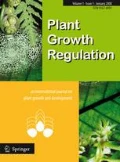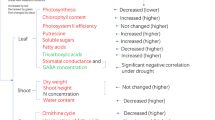Abstract
Water deficit limits plant growth and yield. Arbuscular mycorrhizal (AM) symbiosis is viewed as one of the several methods to improve growth under water deficit. The present study investigated the growth performance in relation to water deficit in two cultivars (“H2” and “660”) of AM treated macadamia (Macadamia tetraphylla L.) plants. AM treatment significantly improved the growth in macadamia plants that have been subjected to water deficit (7 % soil water content) for 14 days. Leaf water content (LWC) and maximum quantum yield of PSII (Fv/Fm) in AM-associated plants were maintained better than those in the control (well-watered) plants. A positive correlation was observed between LWC and Fv/Fm in “H2” cultivar. AM treatment enhanced proline and soluble sugar content in “H2” cultivar under water deficit stress. In contrast, only soluble sugars were accumulated in the AM-associated plants of “660” cultivar under water deficit stress. The study concludes that soluble sugars and proline are involved as key signals of osmoregulation defense response, improve water relation in plant tissues, and thereby resulting in improved growth in AM-associated macadamia plants.





Similar content being viewed by others
References
Abbaspour H, Saeid-Sar S, Afshari H (2011) Improving drought tolerance of Pistacia vera L. seedlings by arbuscular mycorrhiza under greenhouse condition. J Med Plant Res 5:7065–7072
Asrar AA, Abdel-Fattah GM, Elhindi KM (2012) Improving growth, flower yield and water relations of snapdragon (Antirhinum majus L.) plants grown under well-watered and water-stress conditions using arbuscular mycorrhizal fungi. Photosynthetica 50:305–316
Augé RM (2001) Water relations, drought and vesicular-arbuscular mycorrhizal symbiosis. Mycorrhiza 11:3–42
Augé RM, Stodola AJW, Tims JE, Saxton AM (2011) Moisture retention properties of a mycorrhizal soil. Plant Soil 230:87–97
Baslam M, Goicoechea N (2011) Water deficit improved the capacity of arbuscular mycorrhizal fungi (AMF) for inducing the accumulation of antioxidant compounds in lettuce leaves. Mycorrhiza 22:347–359
Bates LS, Waldren RP, Teare ID (1973) Rapid determination of free proline for water-stress studies. Plant Soil 39:205–207
Bohnert HJ, Nelson DE, Jensen RG (1995) Adaptations to environmental stresses. Plant Cell 7:1099–1111
Boomsma CR, Vyn TJ (2008) Maize drought tolerance: potential improvements through arbuscular mycorrhizal symbiosis? Field Crops Res 108:14–31
Coombs J, Hall DO, Long SP, Scurlock JMO (1987) Techniques in bioproductivity and photosynthesis. Pergamon, Oxford
Espeleta JF, Eissenstat DM, Graham JH (1999) Citrus root responses to localized drying soil: a new approach to studying mycorrhizal effects on the roots of mature trees. Plant Soil 206:1–10
Fan QJ, Liu JH (2011) Colonization with arbuscular mycorrhizal fungus affects growth, drought tolerance and expression of stress-responsive genes in Poncirus trifoliata. Acta Physiol Plant 33:1533–1542
Gitonga LN, Muigai AWT, Kahangi EM, Ngamau K, Gichuki ST (2009) Status of macadamia production in Kenya and the potential of biotechnology in enhancing its genetic improvement. J Plant Breed Crop Sci 1:49–59
Grover M, Ali SK, Sandhya V, Rasul A, Venkateswarlu B (2011) Role of microorganisms in adaptation of agriculture crops to abiotic stresses. World J Microbiol Biotechnol 27:1231–1240
Guo P, Baum M, Grando S, Ceccarelli S, Bai G, Li R, von Korff M, Varshney RK, Graner A, Valkoun J (2009) Differentially expressed genes between drought-tolerant and drought-sensitive barley genotypes in response to drought stress during the reproductive stage. J Exp Bot 60:3531–3544
Hadiarto T, Tran LSP (2010) Progress studies of drought-responsive genes in rice. Plant Cell Rep 30:297–310
Hare PD, Cress WA, van Staden J (1998) Dissecting the roles of osmolyte accumulation during stress. Plant Cell Environ 21:535–553
Karaba A, Dixit S, Greco R, Aharoni A, Trijatmiko KR, Marsch-Martinez N, Krishnan A, Nataraja KN, Udayakumar M, Pereira A (2007) Improvement of water use efficiency in rice by expression of HARDY, an Arabidopsis drought and salt tolerance gene. Proc Nat Acad Sci USA 104:15270–15275
Kaya C, Higgs D, Kirnak H, Tas I (2007) Mycorrhizal colonization improves fruit yield and water use efficiency in watermelon (Citrullus lanatus Thunb.) grown under well-watered and water-stressed conditions. Plant Soil 253:287–292
Loggini B, Scartazza A, Brugnoli E, Navari-Izzo F (1999) Antioxidant defense system, pigment composition, and photosynthetic efficiency in two wheat cultivars subjected to drought. Plant Physiol 119:1091–1099
Mayer DG, Stephenson RA, Jones KH, Wilson KJ, Bell DJD, Wilkie J, Lovatt JL, Delaney KE (2006) Annual forecasting of Australian macadamia crop—integrating tree census data with statistical climate-adjustment models. Agric Syst 91:159–170
Mena-Violante HG, Ocampo-Jiménez O, Dendooven L, Martínez-Soto G, González-Castañeda J Jr, Davies FT, Olalde-Portugal V (2006) Arbuscular mycorrhizal fungi enhance fruit growth and quality of chile ancho (Capsicum annuum L. cv. San Luis) plants exposed to drought. Mycorrhiza 16:261–267
Miransari M (2010) Contribution of arbuscular mycorrhizal symbiosis to plant growth under different types of soil stress. Plant Biol 12:563–569
Monoharan PT, Shanmugaiah V, Balasubramanian N, Gomathinayagam S, Sharma MP, Muthuchelian K (2010) Influence of AM fungi on the growth and physiological status of Erythrina variegata Linn. grown under different water stress conditions. Eur J Soil Biol 46:151–156
Morte A, Díaz G, Rodríguez P, Alarcón JJ, Sanchez-Blanco MJ (2001) Growth and water relations in mycorrhizal and non-mycorrhizal Pinus halepensis plants in response to drought. Biol Plant 44:263–267
Oliveira G, Penũelas J (2004) The effect of winter cold stress on photosynthesis and photochemical efficiency of PSII of twoMediterranean woody species—Cistus albidus and Quercus ilex. Plant Ecol 175:179–191
Ortega U, Duñabeitia M, Menendez S, Gonzalez-Murua C, Majada J (2004) Effectiveness of mycorrhizal inoculation in the nursery on growth and water relations of Pinus radiata in different water regimes. Tree Physiol 24:65–73
Pérez M, Urcelay C (2009) Differential growth response to arbuscular mycorrhizal fungi and plant density in two wild plants belonging to contrasting functional types. Mycorrhiza 19:517–523
Porcel R, Ruiz-Lozano JM (2004) Arbuscular mycorrhizal influence on leaf water potential, solute accumulation, and oxidative stress in soybean plants subjected to drought stress. J Exp Bot 55:1743–1750
Qiao G, Wen XP, Yu LE, Ji XB (2011) The enhancement of drought tolerance for pigeon pea inoculated by arbuscular mycorrhizae fungi. Plant Soil Environ 57:541–546
Roitsch T, Gonzalez MC (2004) Function and regulation of plant invertases: sweet sensations. Trends Plant Sci 9:606–613
Rooney DC, Prosser JI, Bending GD, Baggs EM, Killham K, Hodge A (2011) Effect of arbuscular mycorrhizal colonization on the growth and phosphorus nutrition o Populus euramerricana cv. Ghoy. Biomass Bioenerg 35:4605–4612
Ruan YL, Ye J, Li YJ, Yang GJ, Boyer JS (2010) Sugar input, metabolism and signaling mediated by invertase: roles in development, yield potential and response to drought and heat. Mol Plant 3:942–955
Ruiz-Lozano JM (2003) Arbuscular mycorrhizal symbiosis and alleviation of osmotic stress. New perspectives for molecular studies. Mycorrhiza 13:309–317
Schellenbaum L, Müller J, Boller T, Wiemken A, Schüepp H (1998) Effects of drought on non-mycorrhizal and mycorrhizal maize: changes in the pools of non-structural carbohydrates, in the activities of invertase and trehalase, and in the pools of amino acids and amino acids. New Phytol 138:59–66
Sergeeva LI, Keurentjes JJ, Bentsink L, Vonk J, van derPlas LH, Koornneef M, Vreugdenhil D (2006) Vacuolar invertase regulates elongation of Arabidopsis thaliana roots as revealed by QTL and mutant analysis. Proc Nat Acad Sci USA 103:2994–2999
Shamshiri MH, Mozafari V, Sedaghati E, Bagheri V (2011) Response of petunia plants (Petunia hybrid cv. Mix) inoculated with Glomus mosseae and Glomus intraradices to phosphorous and drought stress. J Agric Sci Technol 13:929–942
Sharma S, Villamor JG, Verslues PE (2011) Essential role of tissue-specific proline synthesis and catabolism in growth and redox balance at low water potential. Plant Physiol 157:292–304
Shi L, Guttenberger M, Kottke I, Hampp R (2002) The effect of drought on mycorrhizas of beech (Fagus sylvatica L.): changes in community structure, and the content of carbohydrates and nitrogen storage bodies of the fungi. Mycorrhiza 12:303–311
Singh LP, Gill SS, Tuteja N (2011) Unraveling the role of fungal symbionts in plant abiotic stress tolerance. Plant Signal Behav 6:175–191
Wu QS, Xia RX (2006) Arbuscular mycorrhizal fungi influence growth, osmotic adjustment and photosynthsis of citrus under well-watered and water stress conditions. J Plant Physiol 163:417–425
Wu QS, Xia RX, Zou YN, Wang GY (2007) Osmotic solute responses of mycorrhizal citrus (Poncirus trifoliate) seedlings to drought stress. Acta Physiol Plant 29:543–549
Wu QS, Xia RX, Zou YN (2008) Improved soil structure and citrus growth after inoculation with three arbuscular mycorrhizal fungi under drought stress. Eur J Soil Biol 44:122–128
Wu QS, Zou YN, He XH (2011a) Difference of hyphal and soil phosphatase activities in drought-stressed mycorrhizal trifoliate orange (Poncirus trifoliate) seedlings. Sci Hortic 129:294–298
Wu QS, Zou YN, He XH, Luo P (2011b) Arbuscular mycorrhizal fungi can alter some root characters and physiological status in trifoliate orange (Poncirus trifoliate L. Raf.) seedlings. Plant Growth Regul 65:273–278
Yang J, Kloepper JW, Ryu CM (2008) Rhizosphere bacteria help plants tolerance abiotic stress. Cell 14:1–4
Yin YG, Kobayashi Y, Sanuki A, Kondo S, Fukuda N, Ezura H, Sugaya S, Matsukura C (2010) Salinity induces carbohydrate accumulation and sugar regulated starch biosynthetic genes in tomato (Solanum lycopersicum L. cv. ‘Micro-Tom’) fruits in an ABA- and osmotic stress-independent manner. J Exp Bot 61:563–574
Zhang Y, Zhong CL, Chen Y, Chen Z, Jiang QB, Wu C, Pinyopusarerk K (2010) Improving drought tolerance of Casuarina equisetifolia seedlings by arbuscular mycorrhizas under glasshouse conditions. New Forest 40:261–271
Acknowledgments
The authors are grateful to Mahidol University and the National Research Council of Thailand (NRCT) for funding support and Dr. Harminder Pal Singh for grammatical checking. We very much appreciate the support and active cooperation of the Mae Fah Luang Foundation under the Royal Patronage.
Author information
Authors and Affiliations
Corresponding author
Rights and permissions
About this article
Cite this article
Yooyongwech, S., Phaukinsang, N., Cha-um, S. et al. Arbuscular mycorrhiza improved growth performance in Macadamia tetraphylla L. grown under water deficit stress involves soluble sugar and proline accumulation. Plant Growth Regul 69, 285–293 (2013). https://doi.org/10.1007/s10725-012-9771-6
Received:
Accepted:
Published:
Issue Date:
DOI: https://doi.org/10.1007/s10725-012-9771-6




